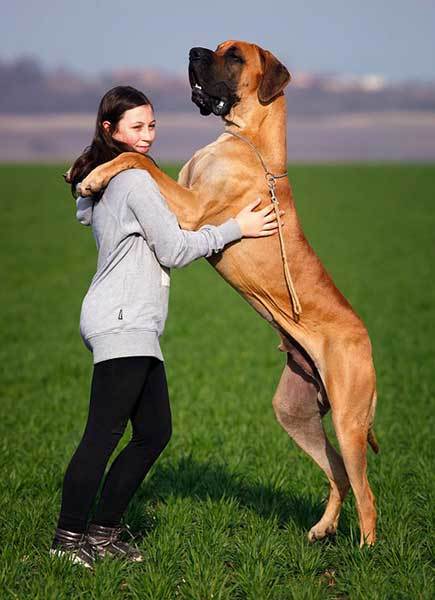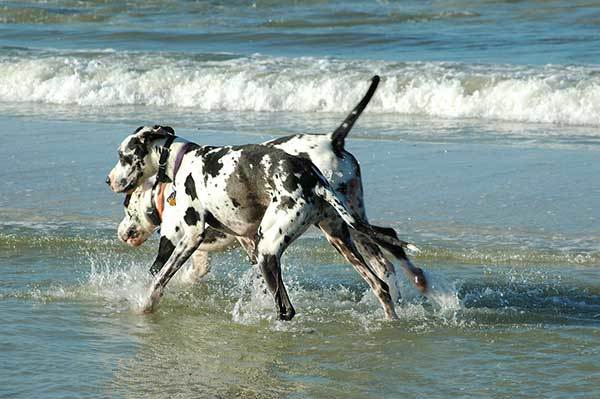Just as the name suggests, Great Danes are some of the largest dog breeds in the world.
If you are looking for a dog that is good at swimming, Great Danes may not feature in your list. This is because you may be tempted to believe their gigantic size makes them less adaptable for swimming.
However, the fact of the matter is that Great Danes are great swimmers. While it is true that they are not natural-born swimmers, these dogs can very efficiently adept at swimming if given the right training and supervision.
However, it is still important to remember that being able to swim does not necessarily mean that a dog likes water.
So, you may be wondering to yourself, do Great Danes like swimming?
Well, a good number of them do not actually like water. So, unlike other breeds like the poodle, do not count on your Great Dane to simply jump into the pool without a reasonable motivation.
Unless you get him excited for a swim, or except in emergency situations like flooding, Great Danes would rather prefer to not go swimming.
In this post, we shall go in-depth about this dog breed and how you can help him not only learn to swim, but also develop an affinity for water. Read on for more insights on the topic.
Table of Contents
What Were Great Danes Developed For?
In order to establish the adaptability of a dog for swimming, it is important to uncover the main reasons why the dog breed was developed in the first place.
Great Danes, also known as Gentle Giants or the Apollo of Dogs, were mainly developed for hunting.

The dog traces its roots in Germany and Austria and became popular in the 16th Century where they were used by the nobility and hunters to bring down the boar, bear and the deer.
Unlike the case with other dog breeds developed for hunting, Great Danes were not really used to chase after wild animals.
Instead, they were used as catch dogs that would hold down an animal after other hunting dogs had seized it. That already speaks to their strength and power.
However, with the emergence of more sophisticated modern hunting weapons, most large breeds that were initially used for hunting were now rendered useless.
Their breeding was no longer controlled and some even went extinct. But due to its resilience, the Great Dane lived on to become one of the giant dog breeds we know of today.

Male Danes can grow up to a height of 31 inches while females can grow to just over 30 inches.
Both adult males and females weigh between 50 and 82 kgs. Their coat comes in a wide collection of colors, from fawn to brindle, blue, mantle, black and harlequin.
Regardless of their difference in coat colors, there is one thing that all Great Danes share in common – their regal appearance, graceful traits as well as powerful, smoothly muscled and well-uniformed bodies. So, how do these features impact the dog’s overall ability to swim?
How Do Great Danes Swim In Comparison To Other Dog Breeds?
You may be wondering to yourself – do Great Danes swim well?
Well, how we answer that question largely depends on the dog breed we compare the Great Danes to.
As we have already mentioned, these dogs are not natural-swimmers. But with proper training, they can become fairly good at swimming.
? When they find themselves in water, Great Danes will do what most dogs will – keep the head above the waterline and paddle using the front limbs so as to avoid sinking.
This motion is generally known as a doggy paddle and is an innate behavior present in all dog breeds, including those that are not naturally-born swimmers.
However, it is important to emphasize that because your Great Dane can naturally do the doggy paddle does not mean he is built for it.
Also remember that swimming involves three basic concepts – the ability to float, move through the water and steer. So, is your Great Dane built for all these three?
Well, the first thing you will need to check is the build of your dog. This especially applies to adult Danes. As you introduce your dog into the water, try to watch out for any signs of struggle.
Usually, most Great Danes would appear to not paddle in uniform motions, or paddle way slower than they should. Also, watch out for any signs that the dog is gasping for breath.
In terms of other breeds, Great Danes are somewhat uniformly-built so that makes them better swimmers compared to breeds like the bulldogs that have relatively heavier heads than the rest of their bodies.
But if you look at other adaptabilities that make a dog an excellent swimmer, breeds like the poodle rank high above the Great Dane.
So, do Great Danes like to swim? As we shall find out later on, that depends on how efficiently you train the do.
ALSO READ: Can German Shepherds Swim?
Features of The Great Dane That Could Make The Dog Learn To Swim Easily
One of the features that make Great Danes fairly easy to introduce to swimming is their large legs. Large legs generally create a larger surface area to volume ratio, making it easy for the dog to paddle.
? Though they have no real developed webbing on their feet, Great Danes can still leverage the length of their legs to ensure they achieve the required paddling motions.
Also, Great Danes are endowed with a large and muscular upper body.
This ensures the dog’s upper body is sufficiently powered with the required energy levels to keep it floating on, and gliding through water.
And considering that much of a dog’s swimming takes place in its fore limbs, it is easier to see how much Great Danes benefit from the high energy around their upper body.
Lastly, Great Danes are characterized by their long snouts. One of the major concerns for any dog is drowning, which is why immediately they find themselves in water, they will often raise their heads high to keep their snouts above the waterline.
Too bad for certain dog breeds like the bulldog whose snouts are almost flat. Now, there is a deeper reason why the snout should seamlessly remain above the waterline.
If it is too short, the dog would be forced to swim with its entire head facing upwards. That would cause the rest of the body to be vertically inclined, making swimming virtually impossible.
Thankfully, the Great Dane is known for long snouts which easily stay above the water level even for a dog still struggling to swim.
How To Teach A Great Dane To Swim?
As Great Danes are not naturally given to swimming, teaching them how to swim may appear like a painstaking process.
However, these dogs are relatively known for their trainability and obedience, which makes for easy training.
As with most Great Danes, expect your dog to be a little nervous when introducing him to water for the first time.
Therefore, the general consensus is to begin from shallow water that is not marked with strong waves and currents. And in order to reassure your dog, you may have to accompany him into the water at the beginning of his swimming classes.

It is also important to remember that Great Danes are dogs that are highly attached to their owners. Therefore, they will always closely follow what their owners are doing. So, you can leverage this endearing trait to show them how to swim.
Get into the water first and sure enough, your Great Dane will follow you there.
As time goes by, your dog should begin to naturally get into the swimming pool on their own. At first, insist in a swimming pool with gentle steps as the dog may find the idea of diving into the pool quite repulsive. The goal is to make your Dane familiar with water so that he is no longer nervous about it.
When teaching your Great Dane how to swim, do not forget the basic swimming gear. As the dog is not a natural swimmer, he will do well with a life vest.
The life vest not only helps your dog float on the water surface, but it also acts as a reflector that enables you to monitor his progress.
You may also consider getting your Great Dane a swimming leash. Again, the leash is instrumental in monitoring the dog as well as saving it in the event it begins to drown.
What If Things Do Not Work Out?
Sometimes, you may realize that the more effort you put into training your Great Dane to swim, the less interested he becomes.
This is especially true for adult Danes. Dogs that have a past traumatic experience with water may prove very difficult to train.So, always do your due diligence to uncover such crucial information.
Another reason why your Great Dane could prove very difficult to train is the mere fact that they are not built for it. That is why experts recommend training Great Dane puppies as opposed to adult dogs. When they are still young, it is easier to introduce Danes to swimming and possibly get them to like it.
But if you still find that things are not working, that is not the end of the world. How about you get an inflatable float-raft for your Dane.
An inflatable float-raft is especially recommended for Danes that like the idea of swimming but just can’t learn the art.
So after rigorous training you realize your dog no longer fears water but still doesn’t seem to have learnt any swimming tricks, get him inflatable float-raft. These float rafts will help the dog stay in the water and enjoy fun times with the rest of the family, regardless of his swimming abilities.
ALSO READ: Can Beagles Swim? Do Beagles Like Water?
So, Can Great Danes Swim?
They can, but with proper training and a great deal of patience. Depending on your dog, he may be instantly taken by the idea, or might find it quite strange.
The saving grace, though, is that even if your Dane does not perfect his swimming abilities, you can still get him a float raft with which he can enjoy being in the swimming pool.


